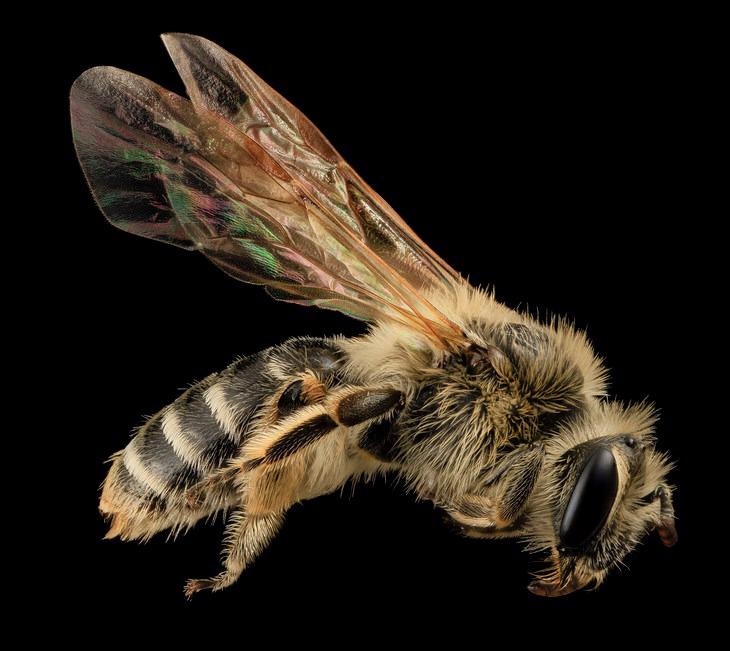Jan 13 2021
According to Penn State researchers, climate change affects wild bees more than disturbances to their habitats. Their findings indicate that mitigating land-use issues alone will not be adequate to safeguard these vital pollinators.
 The researchers analyzed a 14-year United States Geological Survey dataset of wild bee occurrences from more than 1,000 locations in Maryland, Delaware, and Washington, D.C., specifically examining how different bee species and communities respond to land-use and climate factors. The image features a spring bee, one of the species (Andrena nida) the team studied. Image Credit: USGS Bee Inventory and Monitoring Lab.
The researchers analyzed a 14-year United States Geological Survey dataset of wild bee occurrences from more than 1,000 locations in Maryland, Delaware, and Washington, D.C., specifically examining how different bee species and communities respond to land-use and climate factors. The image features a spring bee, one of the species (Andrena nida) the team studied. Image Credit: USGS Bee Inventory and Monitoring Lab.
Our study found that the most critical factor influencing wild bee abundance and species diversity was the weather, particularly temperature and precipitation. In the Northeastern United States, past trends and future predictions show a changing climate with warmer winters, more intense precipitation in winter and spring, and longer growing seasons with higher maximum temperatures.
Christina Grozinger, Distinguished Professor of Entomology and Director of the Center for Pollinator Research, Penn State University
“In almost all of our analyses, these conditions were associated with lower abundance of wild bees, suggesting that climate change poses a significant threat to wild bee communities,” added Grozinger.
Melanie Kammerer, graduate student in entomology at Penn State, noted that few studies have looked into the effects of both climate and land use on wild bees.
We thought this was an oversight because, like many organisms, bees are experiencing habitat loss and climate change simultaneously. By looking at both factors in the same study, we were able to compare the relative importance of these two stressors.
Melanie Kammerer, Graduate Student in Entomology, Penn State University
For their study, the team examined a 14-year United States Geological Survey dataset of wild bee occurrences from over 1,000 locations in Delaware, Maryland, and Washington, D.C., examining in detail how various bee species and communities react to land-use and climate factors.
“To really understand the effects of weather and climate, particularly as weather patterns become more variable with climate change, we need to use these very large, long-term data sets,” stated Grozinger. “We hope that our study, and others like it, will help encourage the collection and integration of these data sets for future research.”
The researchers used spatial models and land-cover maps to illustrate the landscape surrounding each of the sampling locations, including the size of the habitat and accessible floral and nesting resources. Lastly, the team put together a large collection of climate variables and employed machine-learning models to detect the most crucial variables and to measure their effects on wild bees.
The study results have been published in the January 12th issue of Global Change Biology.
“We found that temperature and precipitation patterns are very important drivers of wild bee communities in our study, more important than the amount of suitable habitat or floral and nesting resources in the landscape,” noted Kammerer.
Remarkably, added Grozinger, various bee species were most impacted by changing weather conditions. For example, she said, where there was more rain, there were fewer spring bees.
“We think the rain limits the ability of spring bees to collect food for their offspring,” stated Grozinger. “Similarly, a very hot summer, which might reduce flowering plants, was associated with fewer summer bees the next year.”
Furthermore, warm winters caused a reduction in the numbers of certain bee species.
“This result coincides with studies showing that, with earlier spring onset, overwintering adults had higher pre-emergence weight loss and mortality and shorter life span post-emergence,” Grozinger added.
Kammerer observed that these weather variations would probably worsen in the near future: “In the future, warm winters and long, hot summers are predicted to occur more frequently, which we expect will be a serious challenge to wild-bee populations.”
We are just beginning to understand the many ways that climate influences bees, but in order to conserve these essential pollinators, we need to figure out when, where and how changing climate disrupts bee life cycles, and we need to move from considering single stressors to quantifying multiple, potentially interacting pressures on wild-bee communities.
Melanie Kammerer, Graduate Student in Entomology, Penn State University
According to the Penn team, the study is part of their larger Beescape project, which enables individuals such as conservationists, growers, and gardeners to examine the landscape quality at their site and possibly make alterations to enhance conditions for bees. Given their new discoveries, the researchers plan to increase the scope of Beescape to include weather and climate conditions.
Other authors of the study are Sarah Goslee, ecologist, United States Department of Agriculture Agricultural Research Service; Margaret Douglas, assistant professor of environmental studies, Dickinson College; and John Tooker, professor of entomology, Penn State.
This study was supported by the U.S. Department of Agriculture National Institute for Food and Agriculture, the Foundation for Food and Agriculture Research and the College of Agricultural Sciences and Intercollege Graduate Degree Program in Ecology at Penn State.
Journal Reference:
Kammerer, M., et al. (2021) Wild bees as winners and losers: Relative impacts of landscape composition, quality, and climate. Global Change Biology. doi.org/10.1111/gcb.15485.